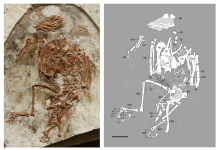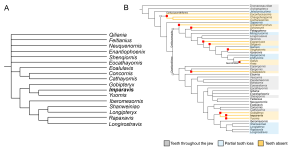Fred Ruhe
Well-known member

Xiaoli Wang, Alexander D. Clark, Jingmai K. O'Connor, Xiangyu Zhang, Xiaoting Zheng & Zhonghe Zhou, 2024
First Edentulous Enantiornithine (Aves: Ornithothoraces) from the Lower Cretaceous Jehol Avifauna
Cretaceous Research (in press): 105867. doi:10.1016/j.cretres.2024.105867. ISSN 0195-6671
ABSTRACT: https://www.sciencedirect.com/science/article/abs/pii/S0195667124000405
Among Mesozoic birds, enantiornithines exhibit great morphological variation, which likely reflects their species diversity, range, and overall success throughout the Cretaceous. The majority of enantiornithines come from the Lower Cretaceous Jehol deposits (130-120 Ma) in northeastern China. In contrast to living birds, most enantiornithines were fully toothed. However, the rostral lengths, appendicular proportions, and pedal morphologies of extant birds can still inform on possible diet, flight mode, and ecology. Both partial (e.g., Longipterygidae) and complete tooth loss (e.g., Yuornis, Gobipteryx) are observed among enantiornithines, with edentulous rostra previously restricted to Upper Cretaceous taxa. Here, we describe the first edentulous enantiornithine from the Lower Cretaceous, Imparavis attenboroughi gen. et sp. nov., indicating a toothless beak evolved in this group 48 Ma earlier than previously recognized. Additionally, we reinterpret Chiappeavis as edentulous which together with the discovery of Imparavis indicates the complete loss of teeth in enantiornithines was not uncommon although still less frequent than observed in ornithuromorphs. The absence of gastroliths in all known enantiornithines suggests that the loss of teeth evolved under different pressures in these two ornithothoracine clades. Differences in rostral occlusion between Imparavis and Chiappeavis suggest they utilized different foraging strategies and possibly diet. Appendicular morphology in Imparavis suggest the capacity for relatively high wing beat frequency and powerful take-off capabilities. Together with the morphology of the hindlimb, we suggest Imparavis was primarily a terrestrial forager that could utilize sudden bursts of flight to escape into arboreal settings as a prey evasion strategy.
Enjoy,
Fred
First Edentulous Enantiornithine (Aves: Ornithothoraces) from the Lower Cretaceous Jehol Avifauna
Cretaceous Research (in press): 105867. doi:10.1016/j.cretres.2024.105867. ISSN 0195-6671
ABSTRACT: https://www.sciencedirect.com/science/article/abs/pii/S0195667124000405
Among Mesozoic birds, enantiornithines exhibit great morphological variation, which likely reflects their species diversity, range, and overall success throughout the Cretaceous. The majority of enantiornithines come from the Lower Cretaceous Jehol deposits (130-120 Ma) in northeastern China. In contrast to living birds, most enantiornithines were fully toothed. However, the rostral lengths, appendicular proportions, and pedal morphologies of extant birds can still inform on possible diet, flight mode, and ecology. Both partial (e.g., Longipterygidae) and complete tooth loss (e.g., Yuornis, Gobipteryx) are observed among enantiornithines, with edentulous rostra previously restricted to Upper Cretaceous taxa. Here, we describe the first edentulous enantiornithine from the Lower Cretaceous, Imparavis attenboroughi gen. et sp. nov., indicating a toothless beak evolved in this group 48 Ma earlier than previously recognized. Additionally, we reinterpret Chiappeavis as edentulous which together with the discovery of Imparavis indicates the complete loss of teeth in enantiornithines was not uncommon although still less frequent than observed in ornithuromorphs. The absence of gastroliths in all known enantiornithines suggests that the loss of teeth evolved under different pressures in these two ornithothoracine clades. Differences in rostral occlusion between Imparavis and Chiappeavis suggest they utilized different foraging strategies and possibly diet. Appendicular morphology in Imparavis suggest the capacity for relatively high wing beat frequency and powerful take-off capabilities. Together with the morphology of the hindlimb, we suggest Imparavis was primarily a terrestrial forager that could utilize sudden bursts of flight to escape into arboreal settings as a prey evasion strategy.
Enjoy,
Fred






